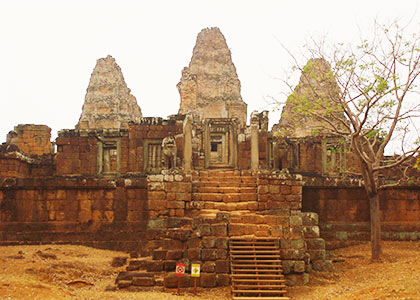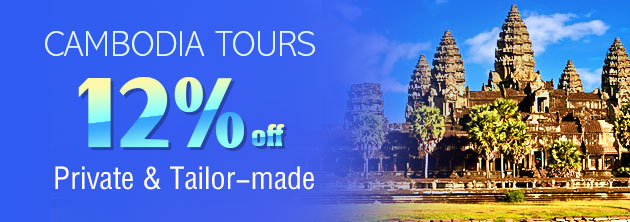East Mebon Temple
The East Mebon Temple is one of the most iconic temples in Cambodia’s Angkor Archaeological Park. The temple dates back to the 10th century and its construction was commissioned by King Rajendravarman II. Before Angkor was abandoned, the temple stood in the middle of a big man-made water reservoir that is known as the East Baray.Due to the temple’s architectural features, it has become one of the most-visited temples in the Angkor Archaeological Park. In this article, we will be taking a closer look at the history and architecture of the East Mebon Temple, and how you can visit it along with the best time to visit it.

East Mebon, Cambodia
|
The History of the East Mebon Temple
According to archaeologists’ estimates, the temple was built in the year 952. Dedicated to Hindu deity Lord Shiva, the East Mebon Temple was also a way for King Rajendravarman II to pay homage to his parents. The temple is located just over a kilometer (0.6 miles) away from King Rajendravarman II’s state temple known as Pre Rup.Awe-Inspiring Architecture of the East Mebon Temple
After Angkor was abandoned, the temple was condemned to being forgotten in time. However, renewed interest in the ancient Angkor Empire during the 1930s led to a number of conservators and explorers doing their best to restore the temples of Angkor to their past glory.Like most temples built during the reign of the Angkor Empire, East Mebon too faces the east. In Hinduism, the east is associated with the rising sun and hence, life.
Unlike some of the Angkor temples built in later years that predominantly featured sandstone as their building material, East Mebon was made from a combination of brick, laterite, and sandstone.
Some of the architectural highlights of the East Mebon Temple are as follows:
• Intricate Stone Carvings: Like many of Angkor’s ancient Hindu temples, East Mebon features some delightful stone carvings that display the prowess of Khmer craftsmanship. All the stone carvings depict scenes from Hindu mythology and some of the most iconic carvings have to be Indra riding Airavata, his three-headed elephant, and Shiva riding Nandi, his sacred bull mount.
• The Landing Stages: The base of the temple features four exquisitely made landing stages that are proof of the fact that once, the temple stood in the center of the East Baray water reservoir. While it has been a long time since the waters of the reservoir dried up, it’s staggering to imagine the beauty of the temple when it was surrounded by water on all sides. Back in the old days, the temple could only be accessed via boats.
• The Stone Elephants: The most exquisite example of ancient Khmer stonework is probably the stone elephants that are situated on the first and second levels of the East Mebon temple. The eight stone elephants are free-standing and in height, they measure 2 meters (6.6 feet).

The Stone Elephants in East Mebon Temple
|
Similarities Compared with Pre Rup Temple
The Khmer architect who was in charge of building the temple was called Kavindrarimathana. His architectural ideas feature profoundly across the prominent temples built in the mid-10th century, with the highlights being the three levels of the temple and the five towers on the uppermost level. Due to the architectural similarities between the East Mebon Temple and the bigger Pre Rup temple, it is often referred to as the “mini Pre-Rup”.There are numerous similarities between the East Mebon Temple and the Pre Rup Temple. The towers of the temple, like the towers of Pre Rup and many other temples in Angkor, symbolize Mount Meru. Mount Meru is one of the most prominent mountains in Hindu mythology and it is known for being the home of several of Hinduism’s most revered deities such as Lord Vishnu, Lord Brahma, and Lord Shiva.
How to Reach the East Mebon Temple?
Siem Reap is the gateway to the Angkor Archaeological Park. The temple is located at a distance of just over 15 km (9.3mi) from the city and there are a number of transport options that tourists can choose from to visit the temple:• Tuk-tuks: A tuk-tuk tour of the famous Angkor temples would set you back by around $15-25.
• Taxis: Private taxis are available but the rates are higher than those charged by tuk-tuk drivers. Expect to spend around $25-50 for a tour of the most prominent Angkor Temples.
• Bicycles: City bikes, speed bikes and mountain bikes are all available for hire. Daily rental rates range from $1-5 and weekly rental rates range from $5-28.
To enter the Archaeological Park, visitors have to pay $37 for a single-day pass, $62 for a three-day pass, or $72 for a seven-day pass. The park remains open for visitors from 9 AM - 6 PM.
The Best Time to Visit the East Mebon Temple
East Mebon temple can be visited every day as the Angkor Archaeological Park remains open throughout the year.The most popular time to visit the East Mebon temple is the winter season when Cambodia remains jam-packed with tourists. Prices of taxis, tuk-tuks and motorbike rentals may be significantly higher due to increased demand.
The off-season months include the summer and monsoon months, during which Cambodia becomes much more peaceful than it is during the peak season. However, these seasons present their own set of challenges for visitors.
While summers are extremely hot and humid, monsoons witness frequent rains. However, if peace of mind and saving money are your priorities, then these make for the ideal times to visit Cambodia and the East Mebon temple.
See More: Best Time to Visit Angkor Wat

